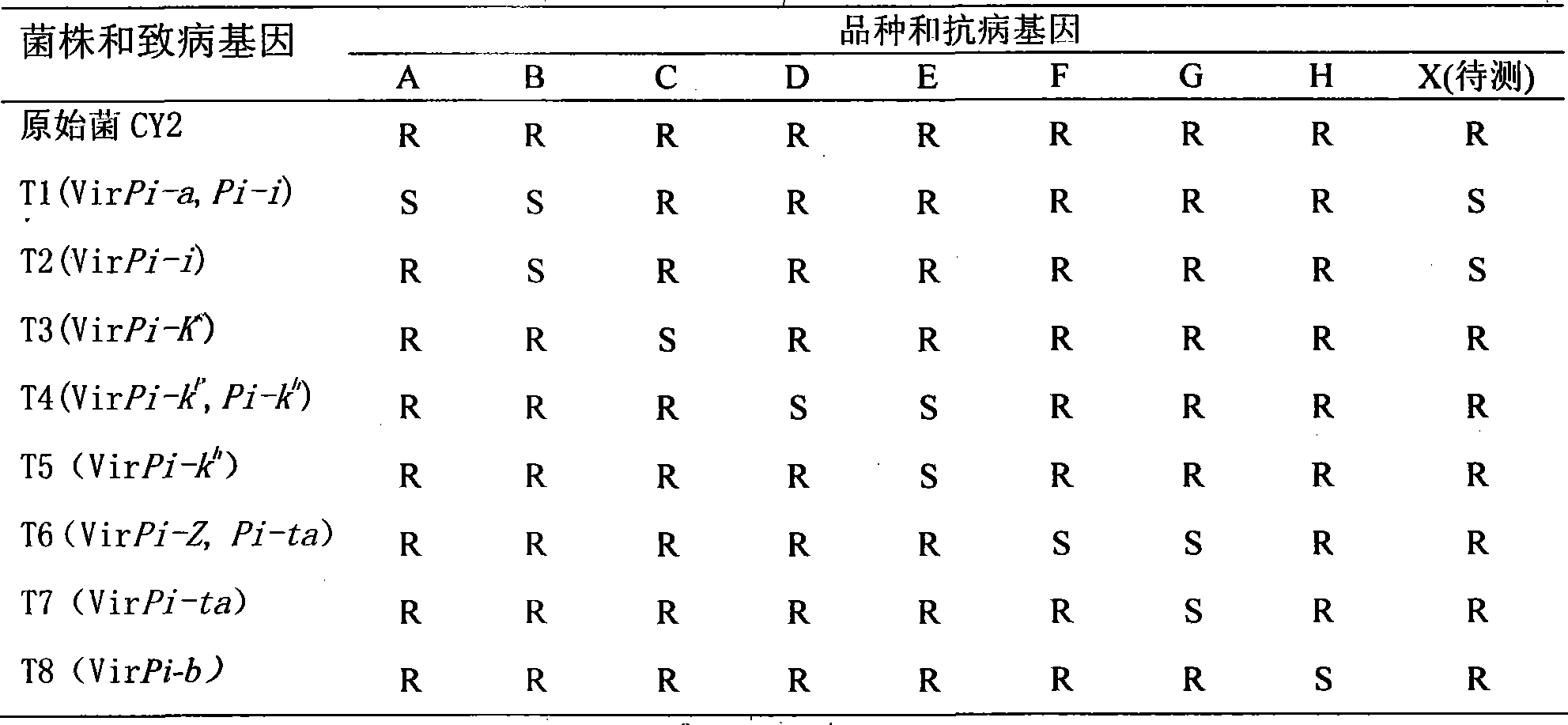Method for analyzing rice blast resisting gene
A technology of rice blast resistance gene and disease resistance gene, which is applied in the fields of biochemical equipment and methods, determination/inspection of microorganisms, etc.
- Summary
- Abstract
- Description
- Claims
- Application Information
AI Technical Summary
Problems solved by technology
Method used
Image
Examples
Embodiment 1
[0015] 1 Using the method mediated by Agrobacterium, transform the widely non-pathogenic strains to obtain CY2, and obtain a large number of transformants;
[0016] 2 Inoculate the obtained transformants on the rice near-isogenic lines of known disease-resistant genes, obtain monospore strains from susceptible disease spots, and connect them back to the near-isogenic lines to confirm the pathogenicity, and obtain 3 The strains T1(VirPi-ta) and T2(VirPi-ta) with mutations in pathogenicity 2 ) and T3 (VirPi-a);
[0017] 3 Sow the rice variety to be tested and three corresponding near-isogenic lines (A, B, C) with known disease-resistant genes in different holes in the seedling tray, and use Lijiang Xintuan Heigu as a susceptible control, and use conventional methods Manage and wait for the seedlings to grow to 3 leaves and 1 heart;
[0018] 4 Cultivate the three strains and the wild-type strain CY2 on oat medium, and prepare spore suspension after sporulation;
[0019] 5. Ino...
Embodiment 2
[0025] 1 Using the method mediated by Agrobacterium, transform the widely non-pathogenic strains to obtain CY2, and obtain a large number of transformants;
[0026] 2. Inoculate the obtained transformants on the rice near-isogenic lines of known disease-resistant genes, obtain monospore strains from susceptible disease spots, and connect them back to the near-isogenic lines to confirm the pathogenicity, and obtain 4 The strains T1 (VirPi-5, Pi-7), T2 (VirPi-7), T3 (VirPi-5, Pi-9) and T4 (VirPi-7, Pi-12) with pathogenic mutations.
[0027] 3 Sow the rice variety to be tested and 4 corresponding near-isogenic lines of known disease-resistant genes in different holes in the seedling tray, and use Lijiang Xintuan Heigu as a susceptible control, manage with conventional methods, and wait until the seedlings grow to 3 leaves and 1 heart are spare;
[0028] 4 respectively culture the 4 bacterial strains and the wild-type strain CY2 on the oat medium, and prepare the spore suspension...
Embodiment 3
[0035] 1 Using the method mediated by Agrobacterium, transform the widely non-pathogenic strains to obtain CY2, and obtain a large number of transformants;
[0036] 2. Inoculate the obtained transformants on rice near isogenic lines with known disease-resistant genes, obtain monospore strains from susceptible lesions, and connect them back to the corresponding lines to confirm the pathogenicity, and obtained 8 The pathogenic strains T1 (VirPi-a, Pi-i), T2 (VirPi-i), T3 (VirPi-K s ), T4 (VirPi-K P , Pi-k H ), T5 (VirPi-k H ), T6 (VirPi-Z, Pi-ta), T7 (VirPi-ta), T8 (VirPi-b);
[0037] 3 Sow the rice variety to be tested and 8 corresponding near-isogenic lines of known disease-resistant genes in different holes in the seedling tray, and use Lijiang Xintuan Black Valley as a susceptible control, manage with conventional methods, and wait until the seedlings grow to 3 leaves and 1 heart are spare;
[0038] 4 Cultivate the 8 strains and the wild-type strain CY2 on the oat mediu...
PUM
 Login to View More
Login to View More Abstract
Description
Claims
Application Information
 Login to View More
Login to View More - R&D Engineer
- R&D Manager
- IP Professional
- Industry Leading Data Capabilities
- Powerful AI technology
- Patent DNA Extraction
Browse by: Latest US Patents, China's latest patents, Technical Efficacy Thesaurus, Application Domain, Technology Topic, Popular Technical Reports.
© 2024 PatSnap. All rights reserved.Legal|Privacy policy|Modern Slavery Act Transparency Statement|Sitemap|About US| Contact US: help@patsnap.com










